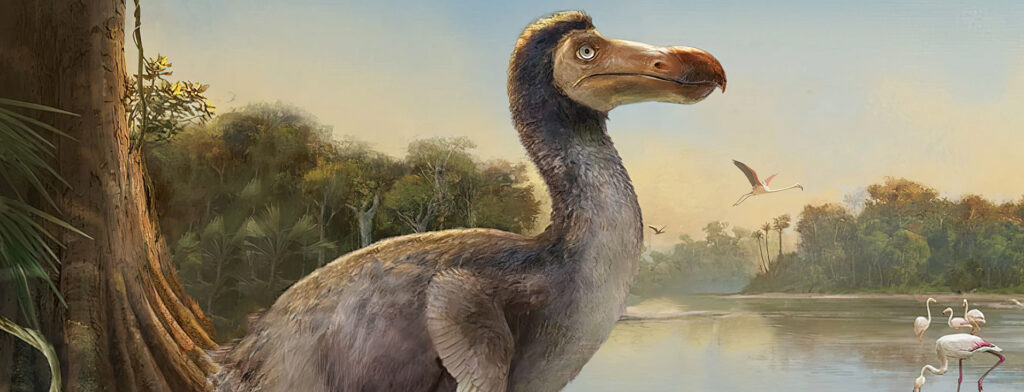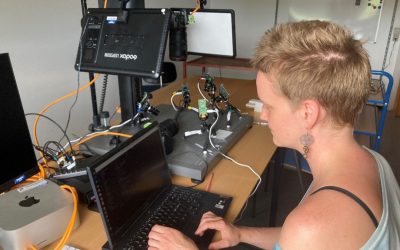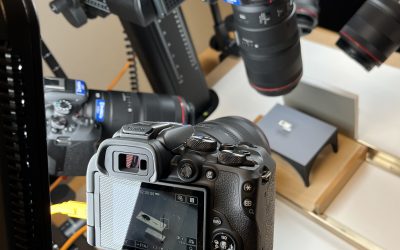Natural History Museum Denmark has released a 3D model of a remarkable and rare dodo skull from its collections. But why is this important?
From ‘Ice Age’ to ‘Alice in Wonderland’, books, drawings, films and animations have cemented the dodo in our imaginations. Its oversized head, wide gaze and prominent nostrils loom large. Or perhaps its impressive girth is what calls your attention, suggesting a slow and ungainly waddle. The word ‘lazy’ hovers around it like the buzz of flies around a corpse. Call someone a ‘dodo’ and like the dodo’s stunted wings, you imply they are obsolete, no longer relevant. With our mental image of the dodo, we express our implicit biases borne of centuries of misunderstanding. But do dodos really deserve this reputation?

Illustration of how the dodo could have looked when alive.
Photo by: McGill Library on Unsplash
What is a dodo?
The dodo is an extinct, flightless bird that lived on the island of Mauritius and nearby islets, to the east of Madagascar. It stood around 1 m tall, with males being larger than females. It probably ate mainly fruit along with nuts, seeds, roots and tubers (Fuller 2002, Hume 2006). This assumption is based on a single account from this time (where it was observed eating fruit) and its large beak (Fuller 2002, Hachisuka 1953).
How do we know about dodos and what did they look like?
The dodo was first recorded by Dutch sailors at the end of the 16th century. Less than 100 years later, it was extinct.
All that remains of encounters with dodos in this 100-year period are a handful of bones, shaky descriptions and some dubious drawings. So little remained, that up until the re-discovery of a dodo skull in the Copenhagen collections in the mid-19th century, most people believed it was a mythical creature.
Descriptions, drawings and paintings based on direct observations of the dodo are rare. Many are copies of others or based on simplified descriptions or dead/decayed animals written by non-scientists (Hume 2006). This is exemplified by the prominent nostril holes in many paintings. It is clear from accounts at the time that the nostril holes were mere slits when the birds were alive (Hume and Cheke 2004). Shrinking of the skin exposed them as round holes after death. There are also very few written observations of the dodo’s behaviour. But study published in the Zoological Journal of the Linnean Society (Young et al. 2024) shows that the dodo actually had tendons in the legs almost the same diameter as the bone itself, indicating that it was extremely agile and speedy – and not lazy at all.

An illustration of the Copenhagen Skull
Illustration by: Jon Fjeldså, Natural History Museum of Denmark
As the dodo had no native mammalian predators, it showed an apparent lack of fear of humans. This may have led to the misconception of it as being lazy or stupid. The new study, which is a collaboration between the University of Southampton, Oxford University and the Natural history Museum, also confirms that they do not deserve that reputation, as they where simply adapted to the ecosystem in the island of Mauritius. They were often depicted as being stout and squat, but this may partly have been due to bad drawings, poor reconstructions, badly stuffed specimens or poor diets of captive animals (Hume 2006).
Where does the name ‘dodo’ come from?
Whilst the origin of the name ‘dodo’ is unclear, the most likely origins are from the Dutch word ‘dodoor’ meaning sluggard or ‘dodaars’ meaning ‘fat-arse’ or ‘knot-arse’ (referring to the feathers on its rear which form a bump; Fuller 2002). Despite these unfortunate labels, a Dutch sailor shipwrecked on Ile d’Ambre (an islet just off the northeast coast of Mauritius) later described his encounter with dodos in 1662. In this account, he claimed that they were able to run swiftly (Cheke 2004). This is the last eyewitness account of a wild dodo.
What specimens remain?
A small number of dodos were transported from Mauritius at the end of the 16th and during the 17th century, including some live specimens. It is difficult to know how many specimens were transported, with estimates between and 17 live individuals (Hume 2006). The ones that we have evidence for were exhibited as curiosities. Unfortunately, very few remains have survived due to the inability to preserve specimens at that time.
The most complete specimen is held at Oxford University Museum (UK) and consists of a mummified head, a few feathers and a foot. The Natural History Museum Denmark holds a complete skull without any skin in its collections (the “Copenhagen skull”) and the Prague National Museum has the front of a skull. No other recent specimen has survived.

The mummified skin from the head of the Oxford dodo represents the only surviving soft tissue available for DNA research.
Photo by: Oxford University Museum
Luckily, the bird is also known from sub-fossil bones (bones which have been buried for long periods of time and have begun to fossilise). Most of these bones are around 4,000 years old. Unfortunately, many are incomplete, with heads and wings being particularly rare.
The Copenhagen skull
“The Natural History Museum of Denmark’s dodo skull is rare because it is modern, which means it was preserved from a live animal and has not fossilised”, says Peter Hosner, Assistant Professor and Curator of Birds at Natural History Museum Denmark.
We do not know exactly when or by whom the Copenhagen skull was collected. We know that it was sent to Holland and became part of the collection of Bernardus Paludanus (a collector of rare objects) in Enkhuizen (present day Netherlands). It is possible that its acquisition was facilitated by Jan Huyghen van Lindschoten. Lindschoten had settled in Enkhuizen in 1592 after visiting the East Indies and enjoyed a close working relationship with Paludanus (Wissen 1995). In 1651, the skull was moved to Gottorf Castle in Schleswig (Germany). Whilst there, it was described by Adam Olearius, who was cultural director to the Dukes of Schleswig, in 1670. Finally, following the occupation of the castle by Danish forces in 1702, the skull was taken to Denmark and added to the Royal Danish collection. If this reconstructed history is correct, it makes the Copenhagen skull the oldest known surviving remains of any of the dodos brought to Europe in the 17th century (Hume 2006).

3D illustration of the Copenhagen skull, specimen NHMD000129015 (ZMUC 90-806/AVES-105485)].
Photo by: Kasper Lykke Hansen, Natural History Museum of Denmark
In 1840, the Copenhagen skull was rediscovered in the collections at the Kongelige Naturhistoriske Museum (Royal Natural History Museum) by Danish zoologist, Johannes Theodor Reinhardt. By this time, most people had forgotten about the dodo. Reinhardt re-examined the specimen and published his findings in 1842. In this publication, he proposed that the dodo was in fact a giant, flightless pigeon. Reinhardt’s claims were initially met with scepticism. But in 2002, DNA extracted from the Oxford specimen proved that Reinhardt was correct (Shapiro et al. 2002). Whilst dodos are most closely related to the, also extinct, Rodrigues solitaire, both are more closely related to pigeons and doves than to other birds and are now placed in the same scientific family as them.

The dodo and its size compared to other pigeons.
Photo from: https://bcs.whfreeman.com/
Why did the dodo go extinct?
The dodo is a symbol of man-made extinction, and we can learn from its history. It is a fascinating creature, with a suite of unique characteristics which evolved to suit its habitat prior to human arrival. It went extinct as a result of hunting by humans and non-native animals introduced to the island (particularly destruction of the eggs and chicks; Cheke 1987, 2013, Hachisuka 1953). These lessons from the past are critical in guiding us on how we interact with habitats and their associated flora and fauna today.
Digitisation
Whilst the dodo is now sadly extinct, its remains continue to inform and inspire us. Access to the specimens is essential if we hope to continue to learn from these lessons of the past. However, many natural history specimens are rare, scientifically valuable and fragile. Preserving them for the future is a primary goal of natural history institutions and providing physical access to them is fraught with risk. This is why digitisation is so important. By digitising the specimens, we can share these important artefacts with the world without exposing them to potential damage. By making digital specimens available we can stimulate further research on this and generate awareness and debate on critical topics such as the extinction of our flora and fauna.
Download your own 3D model of the Copenhagen dodo skull here.
References
Cheke, A. S. 1987. An ecological history of the Mascarene Islands, with particular reference to extinctions and introductions of land vertebrates. In Diamond, A. W. (ed.), Studies of Mascarene Island birds. Cambridge University Press, Cambridge: 5-89.
Cheke, A. S. 2013. Extinct birds of the Mascarenes and Seychelles – a review of the causes of extinction in the light of an important new publication on extinct birds.Phelsuma 21(2013): 4-19.
Cheke, A. 2004. The Dodo’s last island – where did Volkert Evertsz meet the last wild Dodos? Proceedings of the Royal Society of Arts and Sciences of Mauritius VII: 7-22.
Fuller, E. 2002. Dodo – From Extinction To Icon. HarperCollins, London. ISBN 978-0-00-714572-0.
Hachisuka, M. 1953. The dodo and kindred birds. Witherby, London.
Hume, J. P. 2006. The history of the Dodo Raphus cucullatus and the penguin of Mauritius. Historical Biology 18(2): 65–89. DOI: 10.1080/08912960600639400.
Hume, J. P. and Cheke, A. S. 2004. The white dodo of Réunion Island: unravelling a scientific and historical myth. Archives of natural history 31 (1): 57–79.
Hume, J. P., Datta, A. and Martill, D. M. 2006. Unpublished drawings of the Dodo Raphus cucullatus and notes on Dodo skin relics. Bulletin British Ornithologists’ Club, London 126A: 49-54.
Reinhardt, J. T. 1842–1843. Nøjere oplysning om det i Kjøbenhavn fundne Drontehoved. Naturhistorisk Tidsskrift IV.
Shapiro, B., Sibthorpe, D., Rambaut, A., Austin, J., Wragg, G. M., Bininda-Emonds, O. R. P., Lee, P. L. M. and Cooper, A. 2002. Flight of the Dodo. Science 295 (5560). DOI: 10.1126/science.295.5560.1683.
Young M. T., Hume J.P., Day M.O., Douglas R.P.,, Simmons Z. M., White J., Heller M. O., Gostling N .J., August 2024, The systematics and nomenclature of the Dodo and the Solitaire (Aves: Columbidae), and an overview of columbid family-group nomina, Zoological Journal of the Linnean Society, Volume 201, Issue 4.



